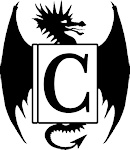The School for Good and Evil
The School for Good and Evil series, Book 1
Soman Chainani
Harper
Fiction, MG? Fantasy
Themes: Books, Buildings With Character, Diversity, Faeries and Kin, Fables, Girl Power, Schools, Shapeshifters, Twists, Witches
****
Description
Sophie and Agatha are different as day and night: one blonde and beautiful and always dressed her best, the other pale and brooding and obsessed with
death and pain. Like all the other children in town of Woods Beyond, the unlikely friends know the story of the School Master: every year, like
clockwork, two children are abducted by a shadowy figure, only to turn up later as illustrations in the fairy tale books that arrive, just as
mysteriously, at the local bookstore. Unlike most other kids, though, Sophie wants to be taken away: the girls in those stories always find a prince and
their happily-ever-after. Agatha doesn't even believe the stories are more than a cover for runaways.
Then Agatha sees the shadow stealing Sophie away, and gives chase - both of them ending up at the School for Good and Evil in the middle of the endless
forest. Only Agatha is dropped into the glass towers of the Good side, where princesses and princes learn the ways of kindness and chivalry to win their
happy endings, and Sophie gets delivered to the foul halls of Evil, where loyalty and friendship and even beauty are considered diseases.
Clearly, there's been some kind of mistake. If anyone from Woods Beyond is a princess it's Sophie, and Agatha must surely be a witch; even the faculty
and students know it. Besides, Agatha doesn't even want to be in a fairy tale. As the two struggle to survive their new classes and figure out how to
escape, they find their bond tested to the utmost as they break the deepest, most basic rule on which the entire school was founded: Good and Evil can
never, ever be friends.
Review
Chainani explores the dark, twisted roots of fairy tales and our concepts of good and evil in this story. From the outset, it's clear that there's at
least a little evil in Sophie and good in Agatha - it's sometimes irritating how obtuse both could be on this aspect - but it's also clear that something
is very wrong with the divisions in the school and the overall balance of power, something only outsiders like the two friends from Woods Beyond can see
and possibly balance, if they can ever get the breathing space beyond just surviving. Sophie spends much of her time in sheer denial of where she is,
fixating on becoming a Good student and winning her prince (Tedros, son of King Arthur and the top boy on the Good campus.) Agatha is reminded by
everyone, especially herself, that she doesn't belong in the Good classes, but her escape plans are constantly thwarted. Meanwhile, their teachers prepare
the children for the deadly game of fairy tales that will be their future... though only the top graduates get leading roles, the rest becoming sidekicks
(or henchpeople), or even transmogrified into animals or plants, which often have unhappy endings no matter which side they're on. (There's a rather
gruesome exhibit in the Good school "honoring" many of these sidekicks in taxidermy form.) These are not Disney fairy tales, or even the watered down
versions from Victorian times; these are fairy tales at their darkest, nightmarish and surreal even when the good people win, and the line between a
happy and a sad ending is often razor thin. There's a deep-rooted unpleasantness at work here that sometimes repelled me, even if it is true to the
original tales, and a few elements of the climax feel subtly unsatisfying. However, this is also one of the most imaginative takes on fairy tale
revisits I've read in some time, with near-nonstop action and many unpredictable twists and turns on the way to an explosive finale. While I'm not sure
if I want to read on yet (I'm still sorting my reaction to a degree, and the To Be Read pile is plenty deep at the moment), all in all I found it a
satisfying, if often gruesome, story.
While Amazon seems reluctant to link to it, I actually read the Barnes and Noble Exclusive Collector's edition, with bonus material that includes two
original "Evil" fairy tales mentioned in the text: "Children Noodle Soup" and "Rabid Bear Rex." They were, indeed, dark stories, and as noted in the text,
true to a world where Good is never guaranteed a win.
As a closing note, I'm a bit on the fence about the age classification. While I tend to see it shelved with middle grade, there are hints and teases toward
the teen end of the market, and I expect the students, like Harry Potter and his friends, mature as the series goes on.
